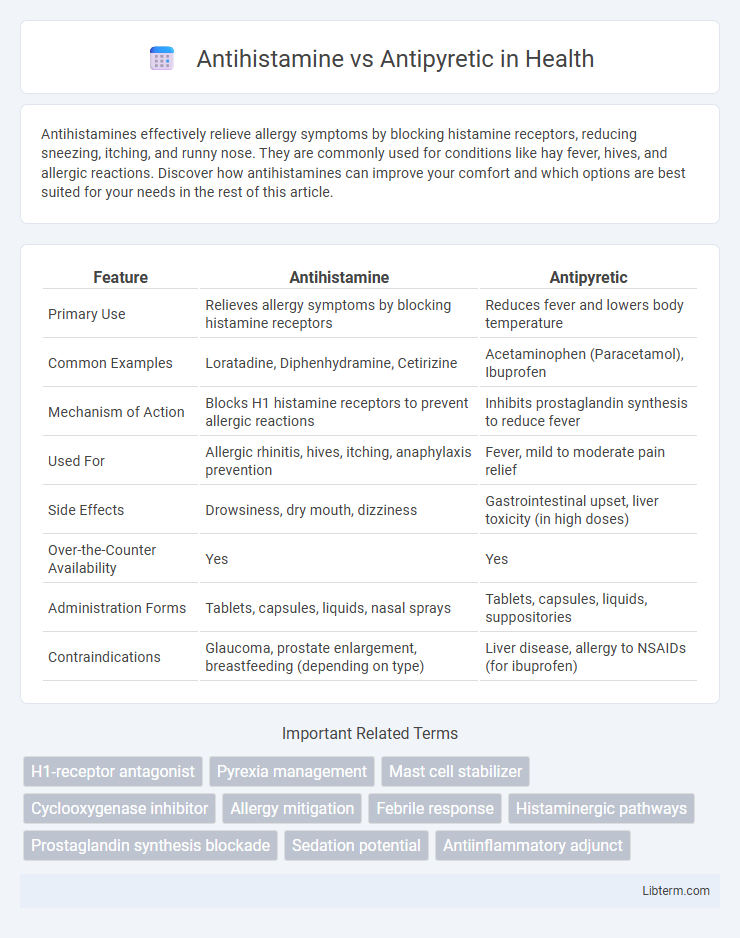Antihistamines effectively relieve allergy symptoms by blocking histamine receptors, reducing sneezing, itching, and runny nose. They are commonly used for conditions like hay fever, hives, and allergic reactions. Discover how antihistamines can improve your comfort and which options are best suited for your needs in the rest of this article.
Table of Comparison
| Feature | Antihistamine | Antipyretic |
|---|---|---|
| Primary Use | Relieves allergy symptoms by blocking histamine receptors | Reduces fever and lowers body temperature |
| Common Examples | Loratadine, Diphenhydramine, Cetirizine | Acetaminophen (Paracetamol), Ibuprofen |
| Mechanism of Action | Blocks H1 histamine receptors to prevent allergic reactions | Inhibits prostaglandin synthesis to reduce fever |
| Used For | Allergic rhinitis, hives, itching, anaphylaxis prevention | Fever, mild to moderate pain relief |
| Side Effects | Drowsiness, dry mouth, dizziness | Gastrointestinal upset, liver toxicity (in high doses) |
| Over-the-Counter Availability | Yes | Yes |
| Administration Forms | Tablets, capsules, liquids, nasal sprays | Tablets, capsules, liquids, suppositories |
| Contraindications | Glaucoma, prostate enlargement, breastfeeding (depending on type) | Liver disease, allergy to NSAIDs (for ibuprofen) |
Introduction to Antihistamines and Antipyretics
Antihistamines are pharmaceutical agents that inhibit the action of histamines, effectively alleviating allergic reactions such as rhinitis, urticaria, and anaphylaxis by blocking H1 or H2 receptors. Antipyretics, including common drugs like acetaminophen and ibuprofen, function primarily to reduce fever by acting on the hypothalamic heat-regulating center. Both antihistamines and antipyretics serve distinct therapeutic roles; the former targets immune responses while the latter manages pyrexia and associated symptoms.
What Are Antihistamines?
Antihistamines are medications that block the action of histamine, a chemical involved in allergic reactions, to relieve symptoms such as itching, swelling, and runny nose. They are primarily used to treat allergies, hay fever, and hives by preventing the body's overreaction to allergens. Unlike antipyretics, which reduce fever, antihistamines specifically target immune responses related to histamine release.
What Are Antipyretics?
Antipyretics are medications designed to reduce fever by acting on the hypothalamus to promote heat dissipation and lower body temperature. Common antipyretics include acetaminophen and nonsteroidal anti-inflammatory drugs (NSAIDs) like ibuprofen, which also provide pain relief and inflammation reduction. Unlike antihistamines, which block histamine receptors to treat allergic reactions, antipyretics specifically target fever management and associated symptoms.
Mechanism of Action: Antihistamine vs Antipyretic
Antihistamines work by blocking histamine H1 receptors, preventing histamine from triggering allergic symptoms such as itching, swelling, and vasodilation. Antipyretics reduce fever by inhibiting the cyclooxygenase (COX) enzymes, particularly COX-2, which decreases prostaglandin E2 synthesis in the hypothalamus, leading to a lowered body temperature set point. This distinct mechanism of action highlights antihistamines' role in allergic responses versus antipyretics' function in fever regulation.
Common Uses and Indications
Antihistamines are primarily used to treat allergic reactions, including hay fever, urticaria, and anaphylaxis, by blocking histamine receptors to reduce symptoms such as itching, swelling, and nasal congestion. Antipyretics are indicated for the reduction of fever and alleviation of mild to moderate pain, commonly used in conditions like influenza, common cold, and post-vaccination fever. Both drug classes serve distinct purposes: antihistamines address immune system-related allergic responses, while antipyretics manage symptoms of fever and inflammation.
Differences in Side Effects
Antihistamines commonly cause drowsiness, dry mouth, and dizziness due to their action on histamine receptors, whereas antipyretics generally have side effects such as gastrointestinal irritation and, in rare cases, liver toxicity when used in excess. Antihistamines may also lead to blurred vision and urinary retention, side effects not typically associated with antipyretics like acetaminophen or ibuprofen. Understanding these differences is critical for managing symptoms effectively and minimizing adverse reactions in patients.
Popular Brands and Generic Options
Antihistamine medications, commonly used for allergy relief, include popular brands like Claritin, Zyrtec, and Benadryl, with generic versions such as loratadine, cetirizine, and diphenhydramine widely available. Antipyretics, used to reduce fever, feature well-known brands like Tylenol and Advil, alongside generic options like acetaminophen and ibuprofen. Both drug classes offer affordable generic medications that provide effective symptom control comparable to their branded counterparts.
Safety Precautions and Contraindications
Antihistamines require caution in patients with glaucoma, urinary retention, and certain cardiovascular conditions due to their anticholinergic effects, while antipyretics like acetaminophen must be used judiciously to avoid hepatic toxicity, especially in those with existing liver disease or chronic alcohol use. Both drug classes demand careful dosage adherence to minimize adverse reactions, such as sedation with first-generation antihistamines or renal impairment linked to excessive NSAID-based antipyretics. Avoid combining multiple medications with overlapping effects without medical supervision to prevent harmful drug interactions and contraindications.
When to Choose Antihistamines or Antipyretics
Antihistamines are best chosen for allergic reactions, hay fever, or symptoms like itching, swelling, and hives caused by histamine release. Antipyretics are ideal for reducing fever and alleviating discomfort during infections or inflammatory conditions. Selecting between antihistamines and antipyretics depends on the primary symptom: antihistamines target allergic responses, while antipyretics address fever and related pain.
Summary: Key Differences Between Antihistamines and Antipyretics
Antihistamines primarily block histamine receptors to relieve allergy symptoms such as itching, swelling, and runny nose, whereas antipyretics reduce fever by acting on the hypothalamus to regulate body temperature. Antihistamines are commonly used for allergic reactions, hay fever, and hives, while antipyretics like acetaminophen and ibuprofen target fever reduction and pain relief. The key difference lies in their mechanisms of action and therapeutic uses, with antihistamines treating allergic responses and antipyretics addressing fever and inflammation.
Antihistamine Infographic

 libterm.com
libterm.com